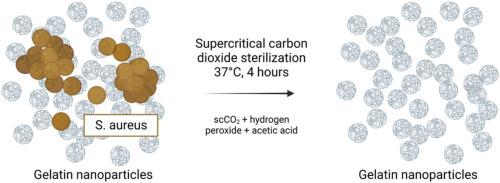The Journal of Supercritical Fluids ( IF 3.9 ) Pub Date : 2023-05-12 , DOI: 10.1016/j.supflu.2023.105979 Lea Andrée , Josephine Dodemont , Harry R. Harhangi , Koen Dijkstra , Laura van Niftrik , Fang Yang , Sander C.G. Leeuwenburgh

|
Nanoparticles (NPs) are widely studied for biomedical applications. Generally, NPs and NP-based materials should be effectively sterilized without altering their structure and function before clinical translation can be considered. However, research on industrially scalable sterilization methods of nanoparticles is still scarce. Therefore, we explored if treatment of gelatin nanoparticles (GNPs) using supercritical carbon dioxide (scCO2) resulted in effective inactivation of Staphylococcus aureus as frequent pathogen causing infections. After scCO2-treatment the morphology, size and surface charge of GNPs remained unchanged, although a slight decrease in crosslinking density was observed. ScCO2 successfully inactivated Staphylococcus aureus in GNPs, as evidenced by a 12-log reduction in bacterial burden. However, cytocompatibility of GNPs was lower after scCO2 treatment, indicating that the process still requires further optimization. Nevertheless, the work presented herein highlights the strong potential of scCO2 for inactivation of pathogens in nanoparticles.
中文翻译:

使用超临界二氧化碳灭活明胶纳米颗粒中的金黄色葡萄球菌
纳米粒子 (NP) 在生物医学应用中得到广泛研究。通常,在考虑临床转化之前,NPs 和基于 NP 的材料应该在不改变其结构和功能的情况下进行有效灭菌。然而,对纳米粒子的工业可扩展灭菌方法的研究仍然很少。因此,我们探讨了使用超临界二氧化碳 (scCO 2 ) 处理明胶纳米颗粒 (GNP ) 是否会导致金黄色葡萄球菌作为引起感染的常见病原体的有效灭活。在 scCO 2处理后,GNP 的形态、尺寸和表面电荷保持不变,尽管观察到交联密度略有下降。ScCO 2成功灭活GNP 中的金黄色葡萄球菌,细菌负荷减少 12 个对数就证明了这一点。然而,经scCO 2处理后GNPs的细胞相容性较低,表明该过程仍需要进一步优化。尽管如此,本文介绍的工作强调了 scCO 2在纳米颗粒中灭活病原体的强大潜力。


























 京公网安备 11010802027423号
京公网安备 11010802027423号